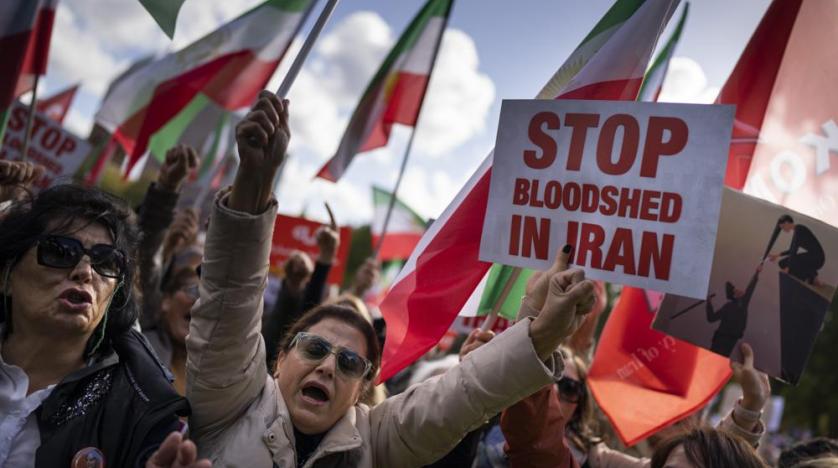Iran: Unhappy Workers
Amir Taheri/Asharq Al Awsat/May 05/2023
إيران: العمال التعساء
أمير طاهري/الشرق الأوسط/05 آيار/203
بعد أن تراجعت إيران في خضمّ المعركة حول فرض الحجاب على النساء، ربما تواجه اليوم تحدياً أشد خطورة بكثير يهدد قبضتها على السلطة. يأتي التحدي من العمال الإيرانيين الذين أطلقوا سلسلة من الإضرابات والاعتصامات، اعتراضاً على ما يعدّونه «استغلالاً ممنهجاً» بحقهم. وبحلول وقت كتابة هذا المقال، يشارك أكثر عن 100 ألف عامل في إضراب عن العمل داخل 122 منشأة تجارية في 35 مدينة إيرانية. ومع أن هذا العدد يبدو قليلاً نسبياً، فإنه يبقى مهماً لسببين: يبدو أن مظاهر الاعتراض تنتشر، إلى جانب أن الإضرابات بدأت في التأثير على المراكز المحورية للاقتصاد، بما في ذلك قطاع الطاقة الحيوي. في هذا الصدد، أعرب جواد زارع، الذي يتولى مراقبة حركة العمال الإيرانيين، عن اعتقاده بأنه: «ربما بدأ البركان النائم في الاستيقاظ. وما نعاينه اليوم أول مؤشرات الانفجار القادم».
في مقال لها عام 2015، تساءلت الباحثة شوكوه مرزادهغي: لماذا يتحمل العمال الإيرانيون «ظروفهم بمثل هذا الصبر»؟
والآن، هل بدأ هذا الصبر ينفد؟ لا يزال من المبكر للغاية الإجابة عن هذا السؤال، لكن المؤكد أن الصبر المذكور سلفاً ينحسر اليوم.
من ناحيته، قال رحمة الله بارتووي، رئيس الاتحاد الإسلامي للعمال، إن أكثر عن 70 في المائة من العمال الإيرانيين يعيشون تحت «خط الفقر» الرسمي. في المقابل، يقدّر علي رضا محجوب، عضو المجلس الإسلامي (البرلمان)، النسبة بـ90 في المائة.
المؤكد أن منظمة العمل الدولية تضع إيران في المرتبة 160 من بين جميع الدول الأعضاء بالأمم المتحدة من حيث متوسط الأجور. وتأتي إيران بذلك في مرتبة متأخرة حتى عن السودان ومالي وغامبيا وأفغانستان (قبل عودة جماعة «طالبان» للحكم). عام 2022 بلغ متوسط الأجور في إيران 75 دولاراً شهرياً. ومع ارتفاع معدل التضخم الرسمي الآن إلى 50 في المائة، تعرّض متوسط القوة الشرائية لهذه الأجور لمزيد من التراجع.
المفارقة أن الأساطير الإيرانية تجعل من كاوه، الحدّاد الذي يمثل الطبقة العاملة، بطلاً وطنياً يقود انتفاضة وطنية ضد الضحاك، الحاكم المستبد الغاصب، من أجل إعادة فريدون، وريث العرش الفارسي، للحكم وتنصيبه ملكاً. ومن المفترض أن المئزر الذي كان يرتديه كاوه، وكان مصنوعاً من الجلد، تحول إلى العَلم الوطني لإيران على امتداد جيل واحد على الأقل.
اليوم، أصبح لدى كاوه اهتمامات أكثر ارتباطاً بالمعيشة والحياة اليومية.
بدايةً، يرغب العمال في استعادة قانون العمل السابق على الثورة. بالتوافق مع القواعد المقررة من منظمة العمل الدولية، وفّر هذا القانون للعمال الإيرانيين إطار عمل تقدمياً يعترف بكرامتهم، ويمنحهم الحق في تكوين نقابات عمالية ووقف العمل للتعبير عن الاعتراض. كما حدد القانون يومَ وأسبوعَ العمل، ونص على إجازات أسبوعية وسنوية للعامل، وكفل إعانات بطالة ومعاشات.
الأهم من ذلك، أن القانون ألزم بضرورة وضع عقود توظيف للعمال، مع تأكيده العقود طويلة الأمد، بينما قصر العقود قصيرة الأجل على حالات قليلة محددة، أبرزها المنشآت التجارية الصغيرة.
ومع ذلك، نجد اليوم أنه تبعاً لما ذكره فتح الله بايات من «البيت الإسلامي للعمال»، فإن قرابة 90 في المائة من العمال مرتبطون بعقود قصيرة الأجل أو لا عقود على الإطلاق. جدير بالذكر أن العقود قصيرة الأجل يمكن أن تحرم المعنيين من الإجازات القانونية، وقواعد السلامة وإعانات البطالة والمعاشات.
أما المطلب الثاني للعمال في الوقت الراهن، فهو تقدير جميع الأجور بالدولار الأميركي كإجراء حمائي ضد تداعيات التضخم. يُذكر أن الزيادات الرسمية في الأجور التي يجري الإعلان عنها سنوياً، تأتي بالعملة المحلية، الريال، ويمحوها التضخم حتى قبل أن يبدأ سريانها.
ويتمثل المطلب الثالث في استعادة الحق القانوني في الإضراب، الذي أُلغي عام 1978 في إطار قانون العمل الإسلامي. علاوة على ذلك، حظر قانون العمل الإسلامي إنشاء نقابات عمالية مستقلة، ومشاركة العمال في مظاهرات سياسية.
وينقلنا ذلك إلى المطلب الرابع، والمتمثل في استعادة الحق في تكوين نقابات عمالية مستقلة، وتنظيم مظاهرات للدفاع عن المطالب المشروعة للعمال.
ويتمثل المطلب الخامس في استعادة قواعد السلامة داخل أماكن العمل، والآليات اللازمة للحد من حوادث العمل التي كان معمولاً بها قبل الثورة.
اليوم، نجد أنه طبقاً لوزارة العمل الإسلامية، فإن ما يزيد على 12000 «حادث خطير بمكان العمل يسبب إصابات خطيرة أو وفاة» تقع سنوياً. عام 2019 فقد 718 عاملاً أرواحهم جراء حوادث داخل أماكن العمل، وأُصيب 2080 آخرون بإصابات جعلتهم عاجزين عن العمل.
المطلب السادس سحب رجال الدين الرسميين الموجودين في كل مكان عمل يضم أكثر من 50 شخصاً، وتفكيك وحدات كسر الإضرابات الواقعة تحت سيطرتهم. ويصر رجال الدين على مشاركة العمال في صلاة الجمعة، الأمر الذي يحرمهم من جزء من يوم العطلة الأسبوعية الوحيدة لهم.
تجدر الإشارة إلى أن السلطات الإسلامية توظف عناصر مدربة خصيصاً على كسر الإضرابات، فيما يعرف باسم «جهاد البناء»، والذين يجري تعزيزهم بقوات من وحدات الباسيج شبه العسكرية عندما يتطلب الأمر.
وتتجلى المفارقة هنا في أن إيران عام 1929 كانت أول دولة آسيوية تقرّ قانوناً للعمل، وتحدد عدد ساعات العمل بثماني ساعات وتفرض حصول العمال على عطلة ليوم واحد في الأسبوع. وفي العام ذاته، أنشأت إيران صندوقاً للبطالة والتقاعد، وكان أول من استفاد منه العمال بصناعة النفط.
عام 1934، تأسس المكتب الوطني للعمل، والذي تطور لاحقاً ليصبح وزارة العمل عام 1944، وكان للوزارة مقعد داخل مجلس الوزراء.
من جهة أخرى، تدّعي آلة الدعاية الرسمية في طهران أن «مجموعات مرتزقة يسارية»، على صلة بـ«الشيطان الأعظم»، أميركا، و«العدو الصهيوني»، تقف خلف موجة الإضرابات الحالية. وقال إمام الصلاة بطهران، آية الله أحمد خاتمي، إن «اليسار الملحد» يرغب في خداع العمال، وحرمانهم من «مزايا قواعد العمل الإسلامية».
في الواقع، فإن مسألة كون حقوق العمال قيمة يسارية تعد ادّعاءً شائعاً في أوساط جميع الأنظمة الاستبدادية على اليسار واليمين. الحقيقة أن حكومة حزب المحافظين في بريطانيا العظمى بقيادة بنجامين دزرائيلي، هي من سمحت بتأسيس أول نقابة عمالية في العالم. وأقرت روسيا القيصرية أول قوانين تكفل حقوق العمال عام 1912، وألغاها البلاشفة عام 1920.
وبفضل «مزايا قواعد العمل الإسلامية»، خسر العمال الإيرانيون الكثير مما اكتسبوه خلال سنوات الازدهار الاقتصادي الإيراني في الستينات والسبعينات. وتكشف الأرقام أنه عام 1979، قُبيل استيلاء الملالي على السلطة، شكّل الرجال والنساء المنتمون لطبقة العمال 27 في المائة من أعضاء البرلمان الوطني.
في ظل حكم الملالي، تراجعت النسبة إلى 8 في المائة، مع استحواذ الملالي وأعضاء «الحرس الثوري» الإسلامي على نصيب الأسد.
طبقاً لوزارة النقل والإسكان، فإن 20 في المائة فقط من الإيرانيين في سن العمل يملكون منازل، مقارنةً بـ44 في المائة عام 1979.
من ناحية أخرى، فإنه بخلاف بعض القطاعات الصناعية النخبوية، خصوصاً الطاقة والمعدات العسكرية، يستفيد القليل من العمال الإيرانيين من التدريب أو البرامج التدريبية المصممة لتحديث مهاراتهم وتعزيز إمكاناتهم المهنية. إلى جانب ذلك، اختفت برامج المنح التي كانت منتشرة عبر أرجاء البلاد، والتي مكّنت عشرات الآلاف من أبناء العمال من الحصول على تعليم أعلى، بما في ذلك في دول من غرب أوروبا وأميركا الشمالية. وحلّت محلها برامج منح لرجال شباب لبنانيين وعراقيين، وفي الفترة الأخيرة نيجيريين وصينيين، يرغبون في التدرب كملالي في قم أو مشهد.
والآن، إذا أنصتَّ جيداً سيمكنك أن تسمع عقارب ساعة القنبلة الموقوتة داخل أماكن العمل عبر إيران، وهي تدق: تيك – توك، تيك – توك!
Iran: Unhappy Workers
Amir Taheri/Asharq Al Awsat/May 05/2023
Having retreated in the battle over mandatory hijab the Islamic Republic leadership in Tehran may be facing a potentially far more dangerous challenge to its hold on power. The challenge comes from Iranian workers who have launched a series of strikes and sit-ins to protest what they regard as “systemic exploitation.”
By the time of this writing over 100,000 workers were on strike in 122 businesses in 35 cities, relatively small numbers yet significant for two reasons: the protests seem to be spreading and the strikes begin to affect the nerve-centers of the economy including the vital energy industry.
“The sleeping volcano may be waking up,” says Jawad Zar’e who monitors the Iranian workers, movement. “What we see is the first hissings of the coming explosion.”
In her seminal essay in 2015, researcher Shokuh Mirzadehgi wondered why Iranian workers “put up with their condition with such patience.” Is that patience wearing off? It is too early to tell. What is certain is that the patience mentioned above is running out.
Rahmatallah Partovi, head of the Islamic Workers’ Council claims that over 70 percent of Iranian workers live below the official “poverty line”. Alireza Mahjub, a member of the Islamic Majlis (ersatz parliament) puts the figure at 90 percent. What is certain is that according to the International Labor Organization (ILO), Iran ranks 160th among all UN members for average wages, even behind Sudan, Mali, Gambia, and Afghanistan ( before the return of the Taliban.) In 2022 Iranian wages averaged $75 a month. With the official inflation rate now topping 50 percent the average purchasing power of those wages has declined further.
Ironically, Iranian mythology casts Kaweh, an ironsmith and thus representing the working people, as the national hero who leads the national uprising against the usurper despot Zahhak to restore Fereidoun, heir to the Persian throne as king. Kaweh’s apron, made of leather, is supposed to have become mythical Iran’s national flag for at least a generation.
Today’s Kaweh has more mundane concerns. To start with they want the pre-revolution Labor Code restored.
Based on ILO rules, that code offered Iranian workers a progressive framework that recognized their dignity and gave them the right to form trade unions and to withdraw their labor in protest. It also fixed the working day and week, offered weekly and annual holidays, and ensured unemployment benefits and pensions. More importantly, it made working contracts mandatory with emphasis on long-term contracts with short-term employment limited to a few specific cases notably in small businesses. Today, however, according to Fathallah Bayat of the Islamic House of Workers, almost 90 percent of wage-earners are on short-term contracts or with no contracts at all. Short-term contracts could deprive those concerned of legal holidays, safety rules, unemployment benefits, and pensions.
The next demand right now is to calculate all wages in the $US as a buffer against inflation. The official wage increases announced annually are in the local currency, the rial, and are wiped out by inflation even before they come into efct. The third demand is to restore the legal right to strike which was specifically canceled in the 1978 Islamic Labor Law which also forbade the creation of independent trade unions and workers’ participation in political demonstrations and protests. Thus the fourth demand is to regain the right of forming independent trade unions and organizing protests in defense of the workers’ legitimate demands. The fifth demand is the restoration of pre-revolution rules on the safety of the workplace and mechanisms needed to reduce working accidents.
Today, according to the Islamic Ministry of Labor over 1,2000 “serious workplace accidents causing major injuries or deaths” occur each year. In 2019, 718 workers lost their lives as a result of workplace accidents and 2,080 others were disabled.
The sixth demand is to withdraw official clerics attached to every workplace employing more than 50 people and to disband strike-breaking units under their control. The clerics insist on workers attending Friday prayers thus depriving them of part of their only weekly day off. The Islamic authorities employ specially trained strike-breakers known as Construction Jihad, reinforced by paramilitary Baseej (Mobilization) units when and if needed.
Ironically, in 1922 Iran was the first Asian country to promulgate a Labor Code and fix an 8-hour working day and a day off per week. In 1929 Iran established an unemployment and retirement fund, first applied to elite oil workers. In 1934 a National Labor Office was established, developing into a Ministry of Labor in 1944 with a seat in the Council of Ministers.
Official Tehran propaganda claims that “mercenary leftist groups” linked to the American “Great Satan” and the “Zionist enemy are behind the current wave of strikes. Tehran Prayer Leader Ayatollah Ahmad Khatami claims that “the godless left” wants to deceive works and deprive them of the “benefits of Islamic working rules.”
That workers’ rights are somehow a leftist value is a common claim of all despotic regimes of left and right. The fact, however, it was Disraeli’s Conservative government in Great Britain that allowed the first trade unions in the world to be formed. The first pro-labor laws in Tsarist Russia were enacted in 1912 and canceled by the Bolsheviks in 1920.
Thanks to the “benefits of Islamic working rules”, Iranian workers have lost much of what they had gained during Iran’s economic boom years in the 1960s to 1970s. In 1979, just before the mullahs seized power, men and women with working-class backgrounds accounted for 27 percent of the members of the national parliament. Under the mullah that has dropped to 8 percent, with mullahs and Islamic Revolutionary Guard figures getting the lion’s share.
According to the Islamic Ministry of Transport and Housing only 20 percent of Iranian age-earners own their homes, compared to 44 percent in 1979.
Outside some elite industries, notably energy and military hardware, few Iranian workers benefit from training and/or retraining schemes designed to upgrade their skill and enhance their career prospects. The nationwide scholarship schemes that enabled tens of thousands of children of workers to gain higher education, including in Western Europe and North America, have all but disappeared. Their place has been taken by scholarships for Lebanese, Iraqi, Yemeni, and, recently, Nigerian and Chinese young men who wish to train as mullahs in Qom or Mashhad.
If you listen closely you may hear the time bomb that is ticking in work-place across Iran: tick-tack, icky-tack!





















